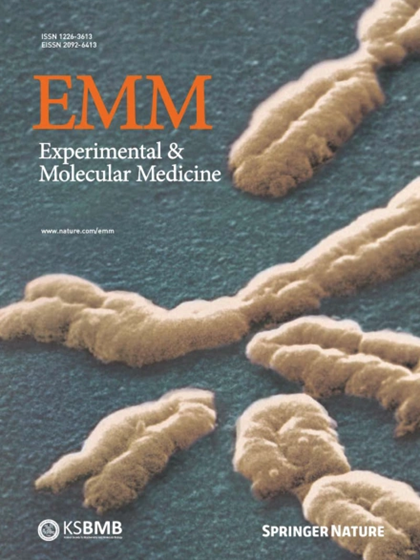The HRAS-binding C2 domain of PLCη2 suppresses tumor‐like synoviocytes and experimental arthritis in rheumatoid arthritis
IF 9.5
2区 医学
Q1 BIOCHEMISTRY & MOLECULAR BIOLOGY
引用次数: 0
Abstract
Fibroblast-like synoviocytes (FLSs), which are stromal cells that play key roles in rheumatoid arthritis (RA) pathophysiology, are characterized by a tumor-like phenotype and immunostimulatory actions. C2 domains in various proteins play roles in intracellular signaling and altering cellular characteristics, and some C2 domain-containing proteins exacerbate or alleviate certain malignant or inflammatory diseases. However, the roles of C2 domains in regulating the functions of RA FLSs remain unclear. Here we performed functional C2 domainomics with 144 C2 domain-containing viral vectors and identified the C2 domain of PLCη2 as a key regulator of RA FLSs. In mice, overexpressing PLCη2 or only its C2 domain PLCη2 (PLCη2_C2) diminished the proliferation, migration, invasion and inflammatory responses of RA FLSs, mitigating RA pathology; the absence of PLCη2 amplified these proinflammatory and destructive processes in RA FLSs in vivo. Mechanistically, PLCη2 and PLCη2_C2 participate in the pathological signaling of RA FLSs in a calcium-independent manner through protein–protein interactions. Specifically, PLCη2_C2 disrupted HRAS–RAF1 interactions, suppressing downstream signaling pathways, including the NF-κB, JAK–STAT and MAPK pathways. Collectively, these findings establish PLCη2 and PLCη2_C2 as novel inhibitory regulators in RA, suggesting promising therapeutic avenues for addressing FLS-driven disease mechanisms. Rheumatoid arthritis is a disease in which the immune system attacks the joints, causing pain and damage. Researchers are looking for new ways to treat RA by targeting specific cells in the joints called fibroblast-like synoviocytes. These cells behave like cancer cells and contribute to joint damage. Researchers studied a protein called PLCη2, which is less active in patients with RA. They used a method called high-throughput screening to find proteins that could be targeted to treat RA. They discovered that increasing PLCη2 levels in FLSs reduced their aggressive behavior and inflammation. The study involved experiments with human cells and mice. The researchers used viral vectors to increase PLCη2 in FLSs and observed reduced cell growth and increased cell death. They also found that PLCη2 interacts with another protein, HRAS, to block harmful signaling pathways. This summary was initially drafted using artificial intelligence, then revised and fact-checked by the author.

plc2o2的hras结合C2结构域抑制类风湿关节炎的肿瘤样滑膜细胞和实验性关节炎。
纤维母细胞样滑膜细胞(FLSs)是在类风湿性关节炎(RA)病理生理中起关键作用的基质细胞,其特征是肿瘤样表型和免疫刺激作用。多种蛋白中的C2结构域参与细胞内信号转导和改变细胞特性,一些含C2结构域的蛋白加重或减轻某些恶性或炎症性疾病。然而,C2结构域在调节RA FLSs功能中的作用尚不清楚。我们对144个含C2结构域的病毒载体进行了功能C2结构域组学研究,发现plc2o2的C2结构域是RA FLSs的关键调控因子。在小鼠中,过表达PLCη2或仅表达其C2结构域PLCη2 (PLCη2_C2)可减少RA FLSs的增殖、迁移、侵袭和炎症反应,减轻RA病理;在体内,plca_2的缺失放大了RA FLSs中的这些促炎和破坏过程。在机制上,plc2o_2和plc2o_2通过蛋白-蛋白相互作用以钙不依赖的方式参与RA FLSs的病理信号传导。具体来说,plca2o - c2破坏了HRAS-RAF1的相互作用,抑制了下游信号通路,包括NF-κB、JAK-STAT和MAPK通路。总之,这些发现确立了plc2o_2和plc2o_2是类风湿关节炎的新型抑制调节因子,为解决fls驱动的疾病机制提供了有希望的治疗途径。
本文章由计算机程序翻译,如有差异,请以英文原文为准。
求助全文
约1分钟内获得全文
求助全文
来源期刊

Experimental and Molecular Medicine
医学-生化与分子生物学
CiteScore
19.50
自引率
0.80%
发文量
166
审稿时长
3 months
期刊介绍:
Experimental & Molecular Medicine (EMM) stands as Korea's pioneering biochemistry journal, established in 1964 and rejuvenated in 1996 as an Open Access, fully peer-reviewed international journal. Dedicated to advancing translational research and showcasing recent breakthroughs in the biomedical realm, EMM invites submissions encompassing genetic, molecular, and cellular studies of human physiology and diseases. Emphasizing the correlation between experimental and translational research and enhanced clinical benefits, the journal actively encourages contributions employing specific molecular tools. Welcoming studies that bridge basic discoveries with clinical relevance, alongside articles demonstrating clear in vivo significance and novelty, Experimental & Molecular Medicine proudly serves as an open-access, online-only repository of cutting-edge medical research.
 求助内容:
求助内容: 应助结果提醒方式:
应助结果提醒方式:


